Handling Pyrophoric and other Air/Water Reactive Materials
Overview of Hazards
Pyrophoric and other air/water reactive materials are among the most dangerous materials that lab personnel work with in the laboratory. They are all highly reactive to oxygen and/or water. Pyrophorics ignite spontaneously upon exposure to air. Water reactive chemicals react violently with water, including the moisture in air, often emitting flammable or toxic gases. The information provided below is meant to provide guidance and is not a substitute for actual hands-on training conducted by experienced laboratory personnel.
Under no circumstances should you underestimate the hazards these materials pose!
Representative examples of some pyrophoric and air/water reactive materials:
| Metal-Hydrides |
|---|
| Sodium borohydride |
| Lithium borohydride |
| Lithium aluminum hydride |
| Sodium hydride |
| Diisobutylaluminum hydride |
| Metals |
|---|
| Potassium |
| Sodium |
| Cesium |
| Francium |
| Rieke metals (magnesium, zinc) |
| Organometallics |
|---|
| Trimethylaluminum |
| Diethyl zinc |
| Dimethyl zinc |
| Butyl lithiums (all) |
| Grignards (all) |
| Non-metals |
|---|
| Trimethylphosphine |
| Fluorine |
| White phosphorous |
| Phosphine |
| Metal Catalysts |
|---|
| Raney nickel |
| Palladium on carbon (after solvent contact) |
| Platinum oxide |
| Metal-Alkoxides |
|---|
| Potassium t-butoxide |
| Sodium methoxide |
| Sodium ethoxide |
| Metalloid/metalloid halides |
|---|
| Silane |
| Germane |
| Tetrachlorosilane |
| Arsine |
| Boranes |
How to Handle Pyrophoric Reagents
An instructional video produced by Dartmouth: https://www.youtube.com/watch?v=iLMl10X0Naw
Due to the severe hazards associated with these materials, consider using a less hazardous reagent (substitution) or a reagent in a less hazardous form (attenuation) when possible. Examples:
- Use a hydrogen transfer agent rather than Raney nickel;
- Use n-BuLi rather than t-BuLi;
- Use NaH 60% dispersion in mineral oil rather than NaH, dry, 95%;
- Use 10% Pd on carbon (wet) rather than 10% Pd on carbon (dry);
- Use 0.1% fluorine gas rather than 99% fluorine gas;
Universal Best Practices While Working with Air and Water Reactive Materials
- Training is mandatory before personnel are allowed to work with pyrophoric or other air/water reactive materials.
- Inexperienced users of air/water reactive materials must be supervised while performing experiments.
- Never work with air/water reactive materials while you are alone.
- All reactions using air/water reactive materials must be performed under an inert atmosphere in a properly operating chemical fume hood, glove box, or appropriate engineering control with functional fire extinguishing devices (class ABC and D fire extinguishers) nearby.
- Have an appropriate spill kit available and ready before beginning work. Sand, metal-x, or lime works well for smothering air/water reactive materials.
- Wear appropriate PPE (gloves, safety glasses, and lab coat; preferably flame-resistant) and avoid wearing clothes that will melt or are highly flammable.
- Clean up and remove from the work area any flammable material that is not necessary.
- Prior to commencing work, flame or oven dry all equipment (e.g., glassware, syringe body, needles, cannula), and then cool it to ambient temperature under an inert atmosphere.
- Manipulation of air/water reactive materials should use locking mechanisms (e.g., Luer-locks) and clamped apparatus connections (e.g., keck, cable).
- Use gas/vacuum manifold systems (with multiple lines) under an inert gas and mineral oil bubblers to prevent over-pressurization. Inert-gas balloons may also be used.
- Have the reaction apparatus staged/setup and fully purged with inert gas, and keep it under low positive pressure before transferring air/water reactive materials to it.
- Use septa to seal reaction vessels as shown in the example below.
- Use ≥16 gauge needles of ~8-12” in length (24” for cannula). Wider gauge needles help prevent the plumbing from being obstructed; however wider gauge needles more readily damage the integrity of Sure/Seals.
*The needle size depends on the volume of liquid being dispensed. For larger quantities, a wider bore needle (16 gauge) is preferred.
- Never use a syringe at its maximum volume. Maximum withdrawal should be ½ to 2/3rd of syringe capacity. Syringe plungers can quickly pop-out near their maximum volume. Examples;
- If you need 5 mL of reagent, use a 10 mL syringe.
- If you need 25 mL of reagent, use a 40 mL syringe.
- If you need >50 mL of air/water reactive material use a cannula, double-tipped needle, or use multiple smaller withdrawings via syringe.
Examples of septa that maybe required for working with air/water reactive materials.
Liquids
Syringe Technique
- Clamp the bottle of reagent to a solid and immovable support to prevent accidental movement. If the bottle is coming from cold storage and is stable at ambient temperature, allow it to come to ambient temperature before working with it.
- Remove the screw cap from the reagent bottle and quickly insert a seal/septum if one is not already in place on the bottle. Insert an inert gas line needle through the septum into the headspace of the reagent to place the contents under low positive pressure of inert gas. Headspace is the gas-filled portion of the reagent bottle above the liquid.
- Purge a syringe and locked needle with inert gas a few times.
- With the plunger fully forward, insert the needle into the reagent bottle through the septum until the needle approaches the bottom of the reagent bottle.
- Draw the reagent out slowly (to avoid air bubbles) with the syringe pointing downward until a small excess of reagent is withdrawn.
- Flip the syringe so that the plunger is pointing upward and not toward the researcher and allow the gas in the syringe to rise to the tip. With the syringe still pointing upward, push on the plunger until reaching the exact volume of liquid desired and any gas bubbles are expelled.
- With the syringe still pointing upward, bring the tip of the needle out of the liquid reagent until it is in the headspace of the reagent bottle; then slowly pull the plunger back to bring in inert gas as a head space inside the syringe. Make sure not to pull the plunger out too far.
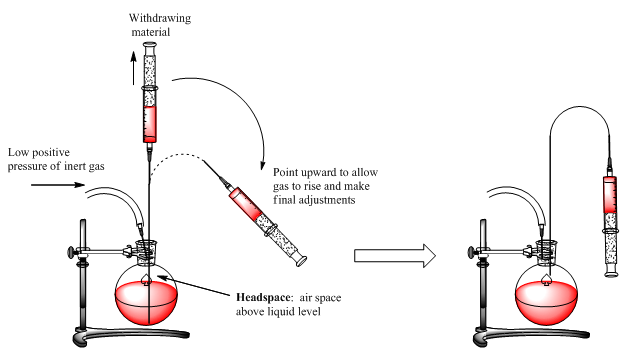
- With the syringe still pointing upward, pull the needle out of the septum of the reagent bottle, but leave the inert gas needle in place. At this point you may see a flame or spark at the needle tip once it comes into contact with the atmosphere. Don’t panic; this is a sign that the reagent is still of good quality, although the lack of a flame or spark does not mean the reagent is not active.
- With the syringe still pointing upward, insert the needle through the septum into the headspace of the reaction apparatus that has already been set up, dried, purged, and is under inert gas. Slowly dispense the contents of the syringe by pushing the plunger of the syringe inward until it stops. Pull back on the plunger to withdraw a few mL of inert gas and remove the needle from the septum of the apparatus.
- Rinse the syringe and needle with a solvent that is the same or compatible with the solvent in which the reactive material was dissolved. Do this by inserting the needle into a flask of the solvent (twice the volume of the syringe) and slowly withdrawing and ejecting the solvent a few times. Then rinse with water and clean as normal.
- Once done with the reagent bottle, withdraw the inert gas needle from the reagent bottle and recap the reagent bottle. Be sure to use parafilm, bakelite caps, or other means to ensure that the air/water reactive liquid remains under inert atmosphere. Place the reagent bottle back into its appropriate storage location.
Cannula/Double-Tipped Needle Technique
All of the above mentioned precautions still apply except that the reaction apparatus should not be placed under low positive pressure of inert gas when the reagent is being transferred. Thoroughly purge the reaction apparatus with inert gas. Then remove the inert gas line inserted via the septum and connect the reaction apparatus to a mineral oil bubbler to allow displaced gas to escape (see illustration below).
- Clamp the bottle of reagent to a solid and immovable support higher in elevation than the reaction apparatus into which you intend to transfer the reagent.
- Remove the screw cap from the reagent bottle and insert an inert gas line needle through the septum into the headspace to place reagent contents under low positive pressure.
- Insert the cannula/double-tipped needle into the reagent bottle through the septum so that the tip is in the headspace of the reagent bottle. Do not insert the tip into the reagent itself!
- Allow inert gas to purge the cannula/double-tipped needle for 5-10 seconds; then insert the other tip of the cannula through the septum into the headspace of the reaction apparatus.
- Insert the cannula tip from the headspace of the reagent bottle into the liquid itself. An immediate transfer of liquid into the reaction apparatus should start to take place.
- Once the desired amount of liquid is transferred, pull the needle tip out of the liquid and into the headspace of the reagent bottle.
- Remove the needle from the reagent bottle, and then immediately remove the other end from the reaction apparatus. Place the reaction apparatus under a low positive pressure of inert gas by inserting a gas line needle from the gas manifold.
- Remove the inert gas line needle from the reagent bottle, seal it, and place it back in its appropriate storage location.
- Clean the cannula by placing a septum over the mouth of a side-arm vacuum flask, inserting the cannula through the septum, applying vacuum to the flask via the house vacuum, and placing the other end of the cannula into a flask of compatible solvent so that the solvent is pulled through the cannula.
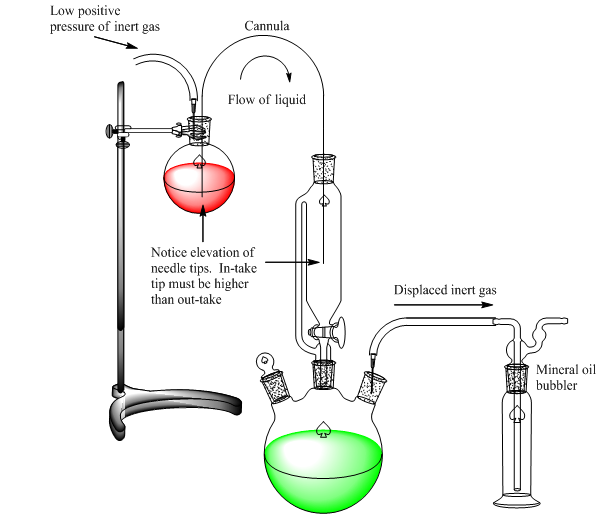
Alternative Cannula Technique for a Non-Graduated Apparatus
If the reaction apparatus is not graduated, this technique may be used to transfer a known volume. Everything for this alternative technique is the same as described in the previous technique except for the following:
- Clamp a flame or oven-dried graduated cylinder (at least 10 mL larger than the desired volume of the reactive liquid) to a solid and immovable support. Purge the graduated cylinder with an inert gas by placing a septum over the mouth of the graduated cylinder and inserting an inert gas line needle into the septum as well as a needle connected to a mineral oil bubbler.
- Once the graduated cylinder is cool, remove the inert gas line needle. Then remove the screw cap from the securely clamped reagent bottle and insert an inert gas line needle into the septum to place reagent contents under low positive pressure.
- Insert the cannula/double tipped needle into the reagent bottle through the septum so that the tip is in the headspace of the reagent bottle. Do not insert the tip into the reagent itself.
- Allow inert gas to purge the cannula/double-tipped needle for 5-10 seconds; then insert the other tip of the cannula into the septum of the graduated cylinder.
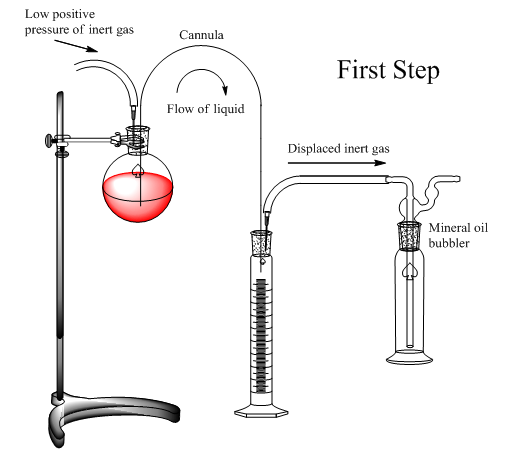
- Insert the cannula tip from the headspace of the reagent bottle into the liquid itself. An immediate transfer of liquid should start to take place into the graduated cylinder.
- Once the desired amount of liquid is transferred, pull the needle tip out of the liquid and into the headspace of the reagent bottle.
- Remove the needle from the reagent bottle, and then immediately insert the same needle tip through the septum into the headspace of the reaction apparatus.
- Cap the reagent bottle and store it appropriately.
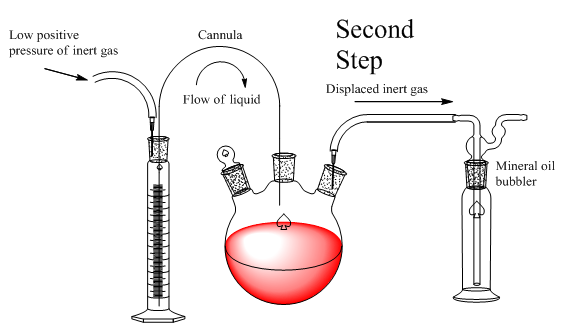
- Transfer the mineral oil bubbler from the graduated cylinder to the reaction apparatus and insert an inert gas line needle into the septum on the graduated cylinder.
- Transfer the reagent from the graduated cylinder to the reaction apparatus in a manner identical to that used to transfer the reagent directly from the reagent bottle to the reaction apparatus. Then remove the cannula in the same manner as was done for the direct transfer.
- Remove the septum from the graduated cylinder. If the reagent is exceptionally reactive, allow the cylinder to sit in the back of the chemical fume hood for a day before cleaning as normal. Otherwise, you may rinse the graduated cylinder with a compatible solvent into a beaker and then quench both the rinse and the residue in the graduated cylinder with an isopropyl alcohol/water/aqueous HCl sequence and dispose of the quenched material as normal.
Solids
Warning: For highly air/water reactive solids use a glove box, the chemical dissolved in a liquid, or oil-coated dispersion form. Consult with DRS or an experienced researcher to determine the preferred technique to handle a specific chemical.
Septum Technique
- Put the vessel (flame or oven dried) into which you intend to place the air/water reactive solid on a stable surface.
- Place the vessel under an atmosphere of anhydrous and inert gas; use a septum inserted into a container/flask and two gas lines for inlet and outlet as shown below. Purge the vessel for a few minutes to remove all oxygen and moist air.
- Open the vessel and quickly insert the spatula into the vessel, and add the air/water reactive solid. Immediately close the vessel and place it under an inert environment. Again, purge the vessel of inert gas for a few minutes. Be sure to keep the original container of air/water reactive solid under an inert atmosphere by using this septum technique on it as well.
- The air/water reactive solid is now ready for use.
- Be sure to purge the original container of air/water reactive solid using anhydrous and inert gas. Then close and parafilm-seal the lid. Return it to storage.
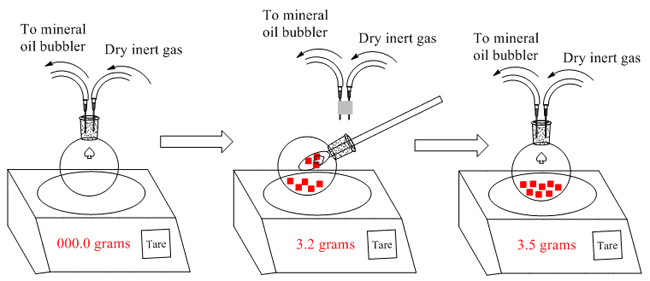
Inverted Funnel Technique
- Put the vessel (flame or oven dried) into which you intend to place air/water reactive solid on a stable surface.
- Use a funnel with a mouth that covers the opening of the vessel into which the air/water reactive solid is to be weighed. Connect an inert gas line to it as shown in the illustration below.
- Start the inert gas flowing, and adjust the flow to a moderately high rate. Be sure the inert gas is anhydrous and that the flow rate will create a blanket of inert gas over the air/water reactive solid as it is being manipulated.
- Once the inverted funnel with inert gas is ready, place it over the vessel into which you intend to transfer the air/water reactive solid to purge the vessel of oxygen or moist air. Allow the vessel to be purged for a few minutes.
- Once purged, very quickly lift up the inverted funnel and use a spatula or other transferring tool to transfer a portion of the air/water reactive solid into the vessel. Lower the inverted funnel immediately so that the air/water reactive solid remains under a blanket of inert gas. Be sure to also keep the original container of air/water reactive solid under an inert atmosphere by using the septum technique illustrated earlier!
- Once the desired amount of air/water reactive solid is transferred, remove the inverted funnel and cover the vessel with a watch glass, lid, or parafilm. Keep the air/water reactive solid under an atmosphere of inert and anhydrous gas.
- Be sure to purge the original container of air/water reactive solid with anhydrous and inert gas. Then close and parafilm-seal the lid. Return it to storage.

The inverted funnel technique can also be used for manipulating air/water reactive materials in odd-shaped and/or irregular pieces of equipment (e.g., pressure tubes, Büchner funnels, beakers, reaction kettles).
Oil-Coated Solid Technique
- Put the vessel (flame or oven dried) into which you intend to place air/water reactive solid on a stable surface and insert a magnetic stir bar.
- Place the vessel under an atmosphere of anhydrous and inert gas. Let it purge for a few minutes to remove all oxygen and moist air.
- Open the vessel and quickly add the oil-coated air/water reactive solid. Immediately after adding the material, place the vessel under an inert environment. Again, purge it of inert gas for a few minutes. Be sure to also keep the original container of air/water reactive solid under an inert atmosphere by using the septa technique illustrated earlier!
- While maintaining an inert atmosphere, inject solvent that will solubilize the oil with which the air/water reactive solid is coated (hexane is usually a good choice). Let it stir for a few minutes, and then stop the stirring so the solid can settle.
- Using a long needle and syringe and without disturbing the settled air/water reactive solid, withdraw all of the solvent. (Using a cannula to decant the liquid is also an option)
- Remove the syringe and needle. Eject the syringe contents into a large beaker and let it sit in the chemical fume hood for a week to slowly react with the air. Quenching the liquid can also be accomplished to cause residual material to react.
- The air/water reactive solid is now ready for use. NOTE: Washing the air/water reactive solid multiple times in this manner may be necessary to remove all traces of the coating oil. Some reactions may not require the removal of dispersion oil.
- Be sure to purge the original container of air/water reactive solid with anhydrous and inert gas. Then close and parafilm-seal the lid. Return it to storage.
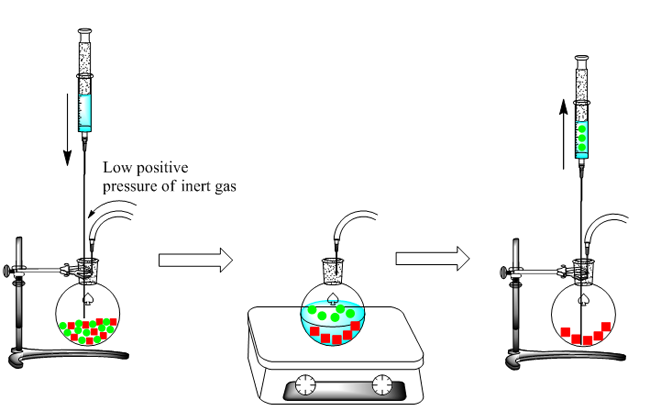
Glove Box Technique
- Fill the main chamber of the glove box with inert gas according to the manufacturer’s recommendations. This is usually done by performing three cycles of filling with inert gas and then evacuating.
- Place the vessel (flame- or oven-dried) and lid into which you intend to place air/water reactive solid in the antechamber along with all the reagents and utensils you intend to use.
- Close the antechamber door and evacuate the antechamber of atmospheric air as the manufacturer recommends. Fill the antechamber with inert gas.
- Once the filling is complete, insert hands/arms into the glove port/sleeve assembly and open the interior antechamber door. Retrieve the vessel, reagents, and utensils you intend to use and place them in the main chamber.
- Close and seal the interior antechamber door and start manipulating the air/water reactive solid as if it were a regular solid chemical.
- Once finished, be certain the vessel containing the air/water reactive solid is closed and sealed. Clean up the main chamber accordingly.
- Once you have confirmed the antechamber exterior door is still closed, open the interior antechamber door and place the vessel, reagents, and utensils in the antechamber.
- Close the interior antechamber door and seal it.
- Open exterior antechamber door to retrieve your vessel of air/water reactive solid and other materials.
- The vessel containing the air/water reactive solid is now ready for use.
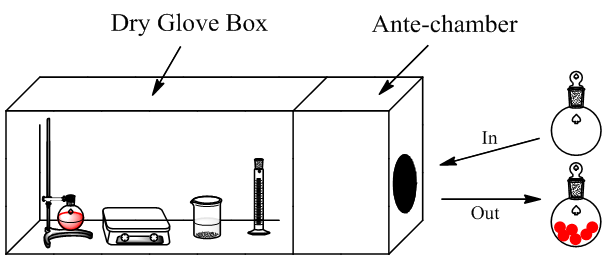
Gases
A few extra notes of caution while working with air/water reactive gases:
- Pyrophoric compressed gas cylinders must be stored in a continuously ventilated gas cabinet with an operational fire suppression system inside the cabinet.
- Use tubing/plumbing that is compatible with the gas (e.g., stainless steel).
- Whenever possible, use outboard/inboard style tubing for air/water reactive gases.
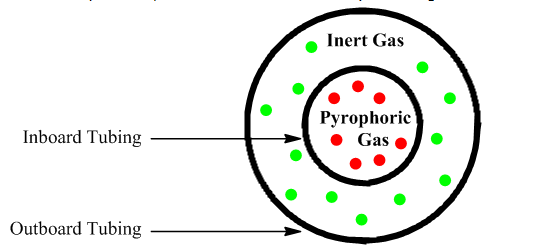
- A burnbox or scrubber device must be used when working with air/water reactive gases.
- A continuously ventilated engineering control (e.g., gas cabinet, chemical fume hood) must be used while working with air/water reactive gases.
- Leak detectors must be used while working with air/water reactive gases.
Regulator for flammable gas. Note notches on flats that indicate left-hand thread.
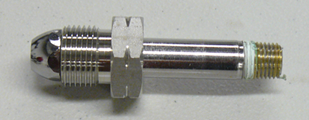
Air/water Reactive Gases
- Secure the compressed gas cylinder against a bracket mounted to a solid structure inside of a gas cabinet or other engineering control.
- Activate chemical leak detectors in the lab.
- Unscrew and remove the compressed gas cylinder cap.
- Install an appropriate CGA regulator using an adjustable wrench. NOTE: Do not use tools with teeth to install a regulator; this will destroy the flat surfaces on the regulator.
- Install additional add-on pressure regulators/gauges as needed, and ensure all valves are closed (turned clockwise). Use Teflon tape as needed on screws, but do not use tape on regulator screws to be inserted into gas cylinder head.
- Purge all in-board plumbing lines downstream of cylinder.
- Ensure that the burnbox or scrubber is on and operational.
- Open the compressed gas cylinder main valve by turning it counterclockwise until open.
- Check leak integrity of connections using soapy water or “snoop.” If no leaks are detected, proceed; if leaks are detected, close all valves and proceed to correct leak connections with Teflon tape or by tightening connections.
- If using pressure gauges, read the levels to ensure they are correct and nothing is amiss.
- Continue opening valves (turning counterclockwise) further downstream, checking each connection for leaks until you reach the outlet pressure valve (last valve before tubing goes to the apparatus that is using the gas).
- Attach tubing from the furthest downstream valve (outlet pressure valve or pressure regulator valve) to the apparatus or device to be used.
- When the apparatus or device is ready, slowly open the outlet pressure valve (turning the knob counterclockwise) to a allow gas to flow. Use the outlet pressure valve or the valve on the pressure regulator (watching the downstream pressure gauge) to adjust gas flow rate to the desired level.
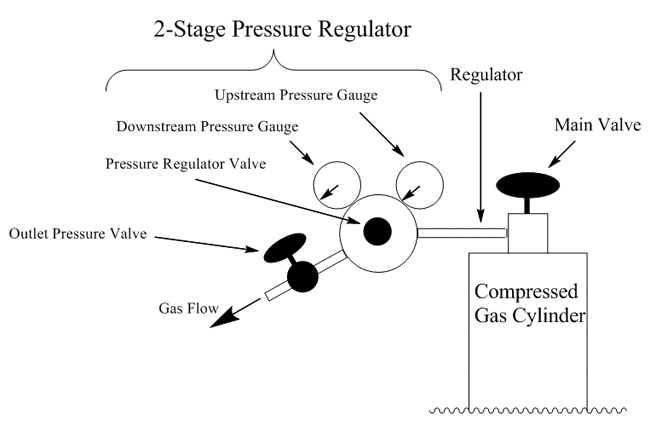
Clockwise Turning = Shutting Off/Reducing Gas Flow
Counter-Clockwise Turning = Opening/Increasing Gas Flow
Shut-down
- Once gas is no longer needed, close the compressed gas cylinder main valve by turning it clockwise until it stops and gas flow stops (check gauges to confirm).
- Purge all tubing lines and plumbing with inert gas.
- Turn off the burnbox or disconnect the scrubber.
- Disconnect tubing from the experimental device that is using air/water reactive gas, and remove tubing from the furthest downstream valve.
- If the compressed gas cylinder is to be removed, close the main valve and open the other downstream valves to release internal pressure of inert gas in the plumbing.
- Use an adjustable wrench to disconnect the pressure regulator from the compressed gas cylinder.
- Place the cap back on the compressed gas cylinder and tighten it.
- Unsecure the compressed gas cylinder from the bracket that is securing it and transport it back (via a cylinder cart) to storage.